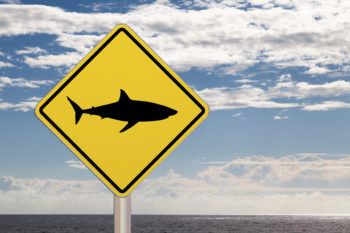Bees And Peanuts Pose Greater Risk Than Shark Attack
It’s that time of year when people head to the beach, and when headlines sometimes scream of a shark attack somewhere along the U.S. coastline. But the chances of being bitten by a shark are so remote they are hardly worth worrying about, says a Texas A&M University at Galveston marine expert.
David Wells, assistant professor of marine biology who has studied sharks for years, says you should deep-six those shark fears. Bottom line: the odds are in your favor.
“There are very few shark attacks worldwide, and Texas’ beaches appear to be some of the safest anywhere,” Wells explains.
The International Shark Attack File, run by the Florida Museum of Natural History, is the world’s leading source on shark attacks. Its records show that from 1959 to 2010, there were 1,970 people killed by lightning strikes in the U.S., compared to 26 shark fatalities.
In Texas during that time, 213 people were killed by lightning while only one shark attack death occurred (there have been two deaths in Texas since 1911, one in Galveston county and one in Cameron county).
Florida appears to be ground zero for both sharks and lightning. Since 1959, it is by far the leader in lightning deaths (459) and shark attack deaths (9).

No doubt, your chances of a shark attack are incredibly small. The Shark Attack File has done the math and the odds of getting killed by a shark are about 1 in 264 million.
Along the Gulf Coast, your chance of getting attacked by an alligator is three to four times higher than a shark attack, statistics show.
Sun seekers should be more concerned about their drive to the beach than shark attacks, Wells says. For that matter, they should be more concerned about dying from a bee sting (50 to 100 people die worldwide, and bee stings kill more people each year than all venomous animals combined).
Even killer sharks are no match for killer peanuts: About 100 people worldwide die annually from an allergic reaction to eating peanuts, according to the Asthma and Allergy Foundation.
While there are numerous kinds of sharks, only four are frequently cited in shark attacks – the bull shark, the tiger shark, the great white shark and the oceanic white tip shark.
“Bull sharks tend to be very aggressive,” Wells says, “and they are commonly seen along the Texas coast.”
Bull sharks have been known to swim many hundreds of miles upstream, such as deep into the Mississippi River, while great white sharks and oceanic white tip sharks are almost never seen off Texas beaches.
“If you want to play it very safe, it’s a good idea not to swim alone,” Wells says.
“And always swim near a lifeguard station. Lifeguards get daily information about possible shark sightings, and they are trained to look for them. And don’t swim too far out, if there are sharks, they are usually found in chest-deep water, and that’s also about where dangerous rip currents can occur.
“At any given moment, there are tens of millions of people in the world who are at the beach and in the water,” he adds. “The odds of not getting bitten by a shark are very much in your favor.”
Media contact: Keith Randall, Texas A&M News & Information Services.





